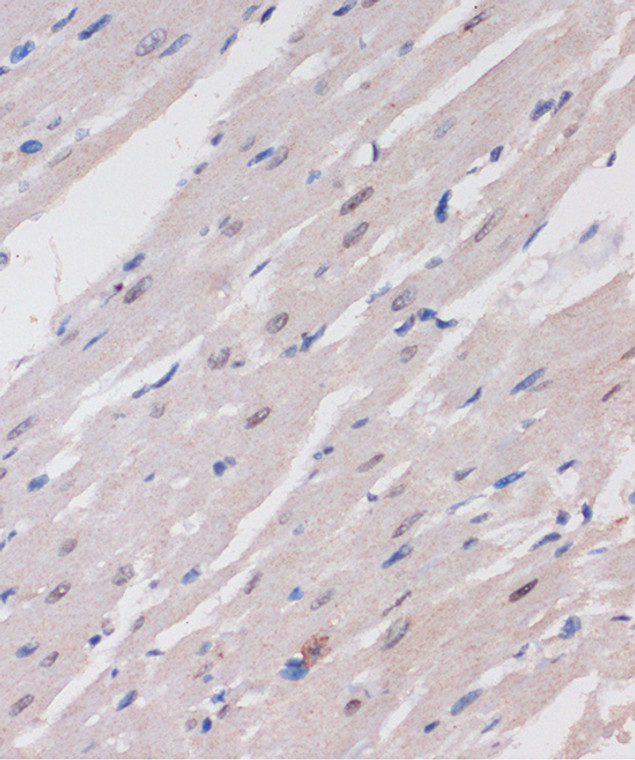| Host: |
Rabbit |
| Applications: |
WB/IHC/IF |
| Reactivity: |
Human/Mouse/Rat |
| Note: |
STRICTLY FOR FURTHER SCIENTIFIC RESEARCH USE ONLY (RUO). MUST NOT TO BE USED IN DIAGNOSTIC OR THERAPEUTIC APPLICATIONS. |
| Short Description: |
Rabbit polyclonal antibody anti-ARID1B (400-650) is suitable for use in Western Blot, Immunohistochemistry and Immunofluorescence research applications. |
| Clonality: |
Polyclonal |
| Conjugation: |
Unconjugated |
| Isotype: |
IgG |
| Formulation: |
PBS with 0.01% Thimerosal, 50% Glycerol, pH7.3. |
| Purification: |
Affinity purification |
| Dilution Range: |
WB 1:200-1:2000IHC-P 1:50-1:200IF/ICC 1:50-1:200 |
| Storage Instruction: |
Store at-20°C for up to 1 year from the date of receipt, and avoid repeat freeze-thaw cycles. |
| Gene Symbol: |
ARID1B |
| Gene ID: |
57492 |
| Uniprot ID: |
ARI1B_HUMAN |
| Immunogen Region: |
400-650 |
| Immunogen: |
Recombinant fusion protein containing a sequence corresponding to amino acids 400-650 of human ARID1B (NP_059989.2). |
| Immunogen Sequence: |
GGFQRFAGQNQHPSGATPTL NQLLTSPSPMMRSYGGSYPE YSSPSAPPPPPSQPQSQAAA AGAAAGGQQAAAGMGLGKDM GAQYAAASPAWAAAQQRSHP AMSPGTPGPTMGRSQGSPMD PMVMKRPQLYGMGSNPHSQP QQSSPYPGGSYGPPGPQRYP IGIQGRTPGAMAGMQYPQQQ MPPQYGQQGVSGYCQQGQQP YYSQQPQPPHLPPQAQYLPS QSQQRYQPQQDMSQEGYGT |
| Tissue Specificity | Widely expressed with high levels in heart, skeletal muscle and kidney. |
| Function | Involved in transcriptional activation and repression of select genes by chromatin remodeling (alteration of DNA-nucleosome topology). Component of SWI/SNF chromatin remodeling complexes that carry out key enzymatic activities, changing chromatin structure by altering DNA-histone contacts within a nucleosome in an ATP-dependent manner. Belongs to the neural progenitors-specific chromatin remodeling complex (npBAF complex) and the neuron-specific chromatin remodeling complex (nBAF complex). During neural development a switch from a stem/progenitor to a postmitotic chromatin remodeling mechanism occurs as neurons exit the cell cycle and become committed to their adult state. The transition from proliferating neural stem/progenitor cells to postmitotic neurons requires a switch in subunit composition of the npBAF and nBAF complexes. As neural progenitors exit mitosis and differentiate into neurons, npBAF complexes which contain ACTL6A/BAF53A and PHF10/BAF45A, are exchanged for homologous alternative ACTL6B/BAF53B and DPF1/BAF45B or DPF3/BAF45C subunits in neuron-specific complexes (nBAF). The npBAF complex is essential for the self-renewal/proliferative capacity of the multipotent neural stem cells. The nBAF complex along with CREST plays a role regulating the activity of genes essential for dendrite growth. Binds DNA non-specifically. |
| Protein Name | At-Rich Interactive Domain-Containing Protein 1bArid Domain-Containing Protein 1bBrg1-Associated Factor 250bBaf250bBrg1-Binding Protein Held/Osa1Osa Homolog 2Hosa2P250r |
| Database Links | Reactome: R-HSA-3214858Reactome: R-HSA-8939243 |
| Cellular Localisation | Nucleus |
| Alternative Antibody Names | Anti-At-Rich Interactive Domain-Containing Protein 1b antibodyAnti-Arid Domain-Containing Protein 1b antibodyAnti-Brg1-Associated Factor 250b antibodyAnti-Baf250b antibodyAnti-Brg1-Binding Protein Held/Osa1 antibodyAnti-Osa Homolog 2 antibodyAnti-Hosa2 antibodyAnti-P250r antibodyAnti-ARID1B antibodyAnti-BAF250B antibodyAnti-DAN15 antibodyAnti-KIAA1235 antibodyAnti-OSA2 antibody |
Information sourced from Uniprot.org
12 months for antibodies. 6 months for ELISA Kits. Please see website T&Cs for further guidance












